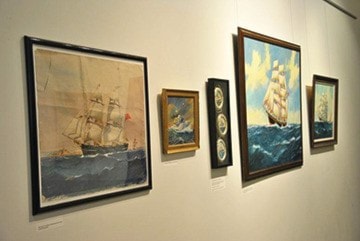They used to turn up fairly often, in antique stores and at shows, sometimes at flea markets and — rarely — at garage sales. But, by now, most of these distinctive lifesaver rings, with their gaudy, hand-coloured scenes, must be in private collections.
Back in May 2002, Nanaimo’s Harbour City Star carried a photo of Qualicum Beach’s Bill Novak, posing with a miniature lifebuoy bearing a painting of his former ship, the Second World War frigate HMCS Charlottetown, ‘Nanaimo, B.C.’ It’s one of the unknown hundreds that were painted by Nanaimo artist Jack Hardcastle, whom the late Hub City historian John Cass remembered for his “knowledge of ships of sail and steamships that gained him fame he did not wish to have”.
The sea ran in Jack’s blood, he and his younger twin brother having been born on board their father’s brig Martha, which sailed out of Whitby, England. The brothers were so alike that even their mother had trouble identifying them. At school, their practical jokes invariably resulted in both lads being caned because the headmaster couldn’t be sure of the guilty party.
Jack homesteaded in Alberta in 1907, later moving to Manitoba where, in 1914, he enlisted with the Grenadier Guards. Wounded, he married while on convalescence leave and the Hardcastles tried Swanson Bay, B.C. before settling in Nanaimo in 1936, where Jack joined the Customs Department.
In 1936 brother Charles arrived from Shanghai. By dressing alike and carrying identical canes, they successfully fooled Jack’s friends for two weeks until one of them finally caught on. They were such clones that even Jack had to use a magnifying glass to identify himself by a favourite tie in an old photo.
All these years, he was painting. Asked how he became a marine artist, he replied, “Wherever I have been, I left a trail of pictures of sailing ships. I even had my paints and brushes at the front lines but had little time to use them.”
His studio, as such, was his backyard or the front room of his house. Visitors often found several paintings in various stages of progress, “each in turn receiving a daub or two of different colours, and allowed to dry,” recounted Cass. “Never a deadline on any picture, some were done within a matter of weeks, others took months to be finished. His workshop was always cluttered with old and new canvases, paint brushes, paints. Jack would reach out and pick any item he required without hesitation. He once remarked, if he decided to straighten up the place it would be utter chaos and he would be lost!”
His growing number of patrons sometimes came from afar.
“Many were men who had sailed on ships of sail or early steamships. They would scrutinize sails, rigging, and be disappointed if they found one detail out of place. Jack had devoted years to collecting nautical books, news items of ships, and old copies of the London Illustrated News.”
Through a telescope situated in his front yard on Haliburton Street he observed marine activities in Nanaimo Harbour.
The CPR sold Newcastle souvenirs of their houseflag within a tiny lifebuoy, and miniature paintings of the ships, and school children came to know some of Jack’s work through their scribbler covers. Water colours of the Hudson’s Bay Co. bark Princess Royal and several other historical ships also went to the B.C. Archives, the Vancouver Art Gallery and HBCo. Offices.
John Cass believed that Jack Hardcastle “never intended to become a painter of recognition, but his vast collection of nautical books dating back 150 years gave him the detailed knowledge to draw or paint any particular ship that he wished to paint. Jack said he thought it was a combination of being the son of a ship’s captain, being born at sea, and a constant observation of ships, along with the box of paints and brushes he took with him wherever he went, that gave him his love of painting ships.”
Five of the six Hardcastle children served in the RCAF during the Second World War, one son being killed in action.
In 1969 Jack Hardcastle was honoured by the City of Nanaimo for his “outstanding contribution to the city in artistic prominence”. He continued to paint in his retirement although his doctor had urged him to rest. But he couldn’t do it. He was working on a canvas when he had to be rushed to hospital, where he died, aged 90, on Aug. 19, 1973.
www.twpaterson.com
